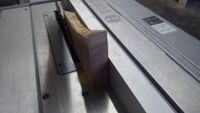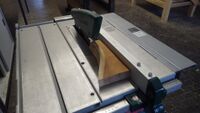Woodturning Blanks: Difference between revisions
Created page with "thumb|300 px|spindle blanks cut from various [[softwood scraps - good for practicing (e.g. file handles), but not..." |
m highlighted some important points |
||
| Line 1: | Line 1: | ||
[[File:softwood spindle blanks.JPG|thumb|300 px|spindle blanks cut from various [[softwood]] scraps - good for practicing (e.g. [[Project:File Handles|file handles]]), but not suited for [[Project:Captive Ring Turning|complex shapes]]]] | [[File:softwood spindle blanks.JPG|thumb|300 px|spindle blanks cut from various [[softwood]] scraps - good for practicing (e.g. [[Project:File Handles|file handles]]), but not suited for [[Project:Captive Ring Turning|complex shapes]]]] | ||
In any [[woodturning]] project, you will start out with a "blank". | In any [[woodturning]] project, you will start out with a "blank". Those can often be quite small and reclaimed from (free) [[Scrap Wood|scrap wood]]! Some even ''literally'' grow on trees, but often you'll need to make some preparations before actually starting to turn. | ||
[[File:center finder on log.JPG|thumb|using a [[3DP|3D printed]] "center finder" to estimate the center of a not exactly round apple log]] | [[File:center finder on log.JPG|thumb|using a [[3DP|3D printed]] "center finder" to estimate the center of a not exactly round apple log]] | ||
In general, you should look for an even grain structure and avoid knots for easier turning. Single flawless pieces are optimal, but with some experience you can also try to fill cracks with a suitable [[resin]] or turn carefully arranged & glued "segmented" blanks. Whatever you end up doing, make sure to estimate the center of the blank as closely as you can to reduce unwanted forces and unneccessary waste of material! | In general, you should look for an '''even grain structure''' and '''avoid knots''' for easier turning. Single flawless pieces are optimal, but with some experience you can also try to fill cracks with a suitable [[resin]] or turn carefully arranged & glued "segmented" blanks. Whatever you end up doing, make sure to '''estimate the center''' of the blank as closely as you can to reduce unwanted forces and unneccessary waste of material! | ||
The more unneeded wood you can remove ''before'' turning, the better! Octagonal blanks are relatively easy to make in most cases, and the extra sawing steps are quickly worth it at larger diameters. | The more unneeded wood you can remove ''before'' turning, the better! Octagonal blanks are relatively easy to make in most cases, and the extra sawing steps are quickly worth it at larger diameters. | ||
Contrary to many other [[woodworking]] techniques, a bit of moisture (or even "green" wood) can be helpful when turning. Very dry, hard woods (e.g. beech table leg used for some [[Project:Tigerente|Tigerente]] wheels) can be hard to cut and produces small chips rather than nice, smooth shavings. | Contrary to many other [[woodworking]] techniques, a bit<sup> how much?</sup> of '''moisture''' (or even "green" wood) can be helpful when turning. Very dry, hard woods (e.g. beech table leg used for some [[Project:Tigerente|Tigerente]] wheels) can be hard to cut and produces small chips rather than nice, smooth shavings. | ||
== Wood Species == | == Wood Species == | ||
Revision as of 18:17, 7 March 2019
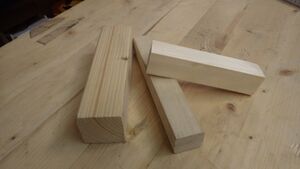
In any woodturning project, you will start out with a "blank". Those can often be quite small and reclaimed from (free) scrap wood! Some even literally grow on trees, but often you'll need to make some preparations before actually starting to turn.
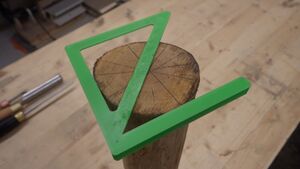
In general, you should look for an even grain structure and avoid knots for easier turning. Single flawless pieces are optimal, but with some experience you can also try to fill cracks with a suitable resin or turn carefully arranged & glued "segmented" blanks. Whatever you end up doing, make sure to estimate the center of the blank as closely as you can to reduce unwanted forces and unneccessary waste of material!
The more unneeded wood you can remove before turning, the better! Octagonal blanks are relatively easy to make in most cases, and the extra sawing steps are quickly worth it at larger diameters.
Contrary to many other woodworking techniques, a bit how much? of moisture (or even "green" wood) can be helpful when turning. Very dry, hard woods (e.g. beech table leg used for some Tigerente wheels) can be hard to cut and produces small chips rather than nice, smooth shavings.
Wood Species
Very soft wood, like fir/spruce, is actually NOT easy to turn, you'll often get tear-out instead of nicely shaven surfaces (similar to planing these woods). So while it's good to start "soft" to understand catches & tool angles, prepare yourself to acquire some higher-quality wood for your take-home projects.
Lukas made very positive experiences with self-dried apple logs, but (cheap) birch logs do not turn much better than softwoods because they are grown too fast.
Spindle Blanks
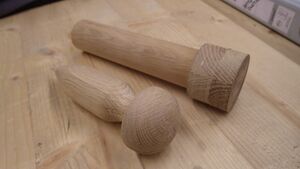
Spindle blanks, i.e. those you would turn lengthwise (and often between centers), ideally have a straight grain along the spindle.
The diameter of these is often quite small and you'll get away with a square blank.
Tree branches and small logs also make great spindle blanks if they're not too curvy!
Cutting Square Blanks
-
step 1: use the narrower width of your stock to set the table saw's parallel fence
-
step 2: lay your stock flat and cut it along its wider width
Bowl Blanks
We do not have a wood lathe capable of serious bowl turning yet! But perhaps we can already collect some information anyway...
